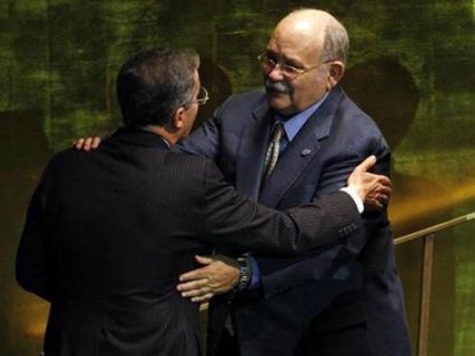Twenty-nine years after having his priesthood suspended by Pope John Paul II, Miguel d’Escoto Brockmann has now been given a green light to return. On friday, the Vatican announced that “The Holy Father has given His benevolent assent that Father Miguel d’Escoto Brockmann be absolved from the canonical censure inflicted upon him, and entrusts him to the Superior General of the Institute [Maryknoll] for the purpose of accompanying him in the process of reintegration into the Ministerial Priesthood.”
The reason for d’Escoto’s 1985 suspension was his refusal to resign from his position as Foreign Minister of the Communist Sandinista dictatorship of Nicaragua. This same regime famously organized a mob to heckle the Pope on his trip to Nicaragua two years earlier.
But d’Escoto’s most notable accomplishment is having received the 1987 “Lenin Peace Prize” from the Communist Party of the Soviet Union. After returning home from Moscow with the prize, he said:
I will say frankly that my first reaction was a feeling of a sort of embarrassment: Am I worthy of such a high award? But then I feel pride, for my people. You see, the Nicaraguan people are waging a heroic battle for peace in the most difficult conditions. This prize makes us Nicaraguans come into even closer contact with Lenin, that great personality of your state and of all mankind who is the passionate champion of peace. For this reason, I am happy to accept this high award, which is conferred on the Nicaraguan people in my person. I believe the Soviet Union is a great torch which emits hope for the preservation of peace on our planet. Always in the vanguard of the overall struggle for peace, the Soviet Union has become the personification of ethical and moral norms in international relations. I admire the revolutionary principles and consistency of the foreign policy of the Communist Party of the fraternal Soviet Union, which provides for deep thought for political and state figures and for philosophers in their struggle for the preservation of peace.
In case anyone needs reminding, here is what “that great personality of your state and of all mankind who is the passionate champion of peace,” Lenin, had written about the Church in a March 19, 1922, directive:
“It is precisely now and only now, when in the starving regions people are eating human flesh, and hundreds if not thousands of corpses are littering the roads, that we can (and therefore must) carry out the confiscation of church valuables with the most savage and merciless energy, not stopping [short of] crushing any resistance.”
We should also examine how well d’Escoto’s regime replicated that “personification of ethical and moral norms,” the Soviet Union:
[T]he Sandinistas did not leave the native populations on the Atlantic coast of Nicaragua in peace. In Khmer Rouge style, they inflicted a ruthless, forcible relocation of thousands of Indians from their land. Like Stalin and Mao, the new regime used state-created famine as a weapon against these “enemies of the people.” The Sandinista army committed myriad atrocities against the Indian population, killing and imprisoning approximately 15,000 innocent people. The Sandinista crimes included not only mass murders of innocent natives themselves, but a calculated liquidation of their entire leadership — as the Soviets had perpetrated against the Poles in the Katyn Forest Massacre, when the Soviet secret police executed approximately 15,000 Polish officers in the spring of 1940.
The Sandinistas quickly distinguished themselves as one of the worst human rights abusers in Latin America, carrying out approximately 8,000 political executions within three years of the revolution. The number of “anti-revolutionary” Nicaraguans who disappeared while in Sandinista hands numbered in the thousands. By 1983, the number of political prisoners inside the new Marxist regime’s jails was estimated at 20,000. This was the highest number of political prisoners in any nation in the hemisphere — except, of course, in Castro’s Cuba. By 1986, a vicious and violent Sandinista “resettlement program” forced some 200,000 Nicaraguans into 145 “settlements” throughout the country. This monstrous social engineering program entailed the designation of “free-fire” zones in which Sandinista government troops shot and killed any peasant of their choosing.
The job of a Christian priest is to guide people to Christ and his kingdom, not to Lenin and the Evil Empire.

COMMENTS
Please let us know if you're having issues with commenting.